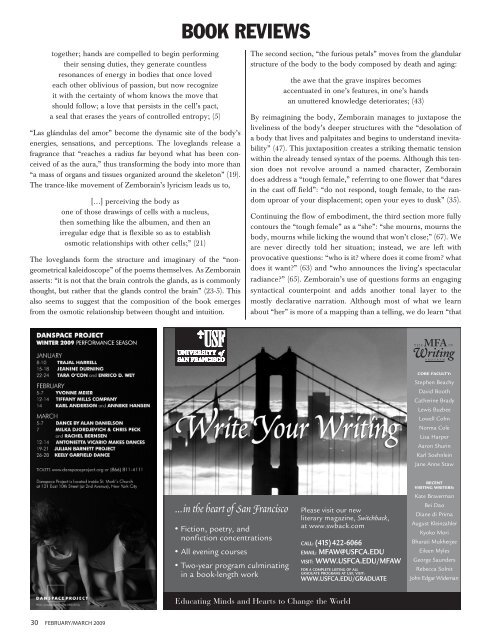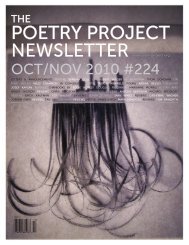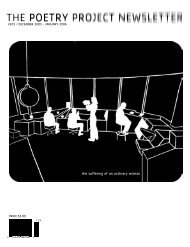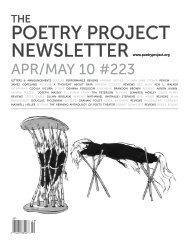BOOK REVIEWStogether; hands are compelled to begin performingtheir sensing duties, they generate countlessresonances of energy in bodies that once lovedeach other oblivious of passion, but now recognizeit with the certainty of whom knows the move thatshould follow; a love that persists in the cell’s pact,a seal that erases the years of controlled entropy; (5)“Las glándulas del amor” become the dynamic site of the body’senergies, sensations, and perceptions. <strong>The</strong> loveglands release afragrance that “reaches a radius far beyond what has been conceivedof as the aura,” thus transforming the body into more than“a mass of organs and tissues organized around the skeleton” (19).<strong>The</strong> trance-like movement of Zemborain’s lyricism leads us to,[…] perceiving the body asone of those drawings of cells with a nucleus,then something like the albumen, and then anirregular edge that is flexible so as to establishosmotic relationships with other cells;” (21)<strong>The</strong> loveglands form the structure and imaginary of the “nongeometricalkaleidoscope” of the poems themselves. As Zemborainasserts: “it is not that the brain controls the glands, as is commonlythought, but rather that the glands control the brain” (23-5). Thisalso seems to suggest that the composition of the book emergesfrom the osmotic relationship between thought and intuition.<strong>The</strong> second section, “the furious petals” moves from the glandularstructure of the body to the body composed by death and aging:the awe that the grave inspires becomesaccentuated in one’s features, in one’s handsan unuttered knowledge deteriorates; (43)By reimagining the body, Zemborain manages to juxtapose theliveliness of the body’s deeper structures with the “desolation ofa body that lives and palpitates and begins to understand inevitability”(47). This juxtaposition creates a striking thematic tensionwithin the already tensed syntax of the poems. Although this tensiondoes not revolve around a named character, Zemboraindoes address a “tough female,” referring to one flower that “daresin the cast off field”: “do not respond, tough female, to the randomuproar of your displacement; open your eyes to dusk” (35).Continuing the flow of embodiment, the third section more fullycontours the “tough female” as a “she”: “she mourns, mourns thebody, mourns while licking the wound that won’t close;” (67). Weare never directly told her situation; instead, we are left withprovocative questions: “who is it? where does it come from? whatdoes it want?” (63) and “who announces the living’s spectacularradiance?” (65). Zemborain’s use of questions forms an engagingsyntactical counterpoint and adds another tonal layer to themostly declarative narration. Although most of what we learnabout “her” is more of a mapping than a telling, we do learn “thatTHEMFA INWritingPROGRAMCORE FACULTY:Stephen BeachyDavid BoothCatherine BradyLewis BuzbeeLowell CohnNorma ColeLisa HarperAaron ShurinKarl SoehnleinJane Anne Staw...in the heart of San Francisco• Fiction, poetry, andnonfiction concentrations• All evening courses• Two-year program culminatingin a book-length workPlease visit our newliterary magazine, Switchback,at www.swback.comCALL: (415) 422-6066EMAIL: MFAW@USFCA.EDUVISIT: WWW.USFCA.EDU/MFAWFOR A COMPLETE LISTING OF ALLGRADUATE PROGRAMS AT USF, VISIT:WWW.USFCA.EDU/GRADUATERECENTVISITING WRITERS:Kate BravermanBei DaoDiane di PrimaAugust KleinzahlerKyoko MoriBharati MukherjeeEileen MylesGeorge SaundersRebecca SolnitJohn Edgar WidemanEducating Minds and Hearts to Change the World30 february/march 2009
BOOK REVIEWSthe moon refused to cohere with her history” (67) and that “sheopens her arms so nothing of her is left” (61-3).Throughout mauve sea-orchids, we lose ourselves in the syntacticcurrents and simultaneously rediscover the body in the embodiedpronouns and evocative images. In Zemborain’s own words,we experience “the body like an arrow tensioned in all directions”(73) and “the body gliding towards the celestial abyss oflight” (79). Reading mauve sea-orchids situates us within its “rítmicaflexión” and transforms how we see and experience ourbodies in the world.Craig Santos Perez is a co-founder of Achiote Press and author of fromunincorporated territory [hacha] (Tinfish Press, 2008).Valentina SaraçiniDreaming EscapeTranslated from the Albanian byErica Weitzmanwith Rudina Jasiniand Flora IsmailiUgly Duckling Presse / 2008Review by Ingrid NelsonIn Michael Powell and Emeric Pressburger’s 1944 film, ACanterbury Tale, the bucolic Kentish landscape that forms both theimpetus for and the terminus of Chaucer’s great poem is steepedin layers of significance. Set during World War II, the film meditateson the continuity land provides to a war-torn country, andon the way history imprints itself on a landscape, fracturing it intothe multiple pasts of memory. In the film’s opening, a medievalpilgrim on the road to Canterbury releases a falcon into the sky.<strong>The</strong> camera follows the bird, then cuts to a World War II fighterjet. In another scene, a young woman who has come to the townfrom London to find wartime work “hears” the songs and voicesof the medieval travellers along the pilgrim’s road that remainson a hill above the town. Every moment of history that plays outon a landscape, the film suggests, is endlessly inscribed on thatlandscape, echoing its joys and its traumas, and shaping thosewho inhabit it. In a time of war, the landscape becomes thenational body on which trauma is enacted, yet also holds thepromise of futurity. In this way, the land is both irreducible andendlessly malleable in human history.If smaller in scale than World War II, the Kosovo war nonethelessscarred its survivors, and the land where it was fought, just asdeeply. <strong>The</strong> Albanian poet Valentina Saraçini’s Dreaming Escaperenders her own vision of the way this war shaped a landscape atonce intimate and transhistorical. In these poems, trauma to thenational body maps on crumbling mountains and perforated treetrunks. <strong>The</strong> resonant sites of history become metonyms for thewar’s impact on human bodies. <strong>The</strong> poem “Tree Trunk” shiftsalmost imperceptibly between landscape and body:When you become a monument to waitingHands raised high neck brokenOne-legged in a time of tatters<strong>The</strong> winds beseech you<strong>The</strong>y are leery of your layered anxieties<strong>The</strong>y gauge the golden silence of your earthYou are leaded<strong>The</strong> leaden pain of centuries<strong>The</strong> silver-white heads of brides’ mothersAnd you a broken branch where no fruit ripens (19)Within the traumatic landscape lives an inert potentiality, locked inby natural processes. Water in all its forms—the sea, ice, fog—is apotent symbol of this paralysis, both psychological and ecological.Other gods will comeOn other mountainsInexorably they rise up from the glaciersAnd the words froze<strong>The</strong> grass too held captiveA vegetal fate(“<strong>The</strong> Grass,” 75)Just as trauma is displaced onto the landscape, another kind ofdisplacement occurs in the dream, an individual’s refuge fromwhat is into what might be. In “<strong>The</strong> Panting,” Saraçini explores thedifficult relationship between dreams and existence:When dreams lay a trap for expectationTruth comes without a soundAnchors the abandoned soulMaybe you rememberBeing has ways of its ownInvisible spiralsAnd never unravels (101)This image of the spiral, whose centrifugal force holds “being”together, describes Saraçini’s poetics. Sensitively rendered in thistranslation, short lines and crystalline images suspend the reader inSaraçini’s scarred, but never irreparable, landscape. Displacementis cathartic in Dreaming Escape, purging trauma into a landscapeand a language that holds the promise of renewal.Ingrid Nelson is writing a book on medieval lyric and song.february/march 2009 31
















